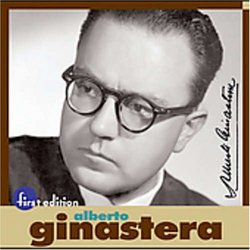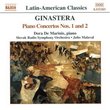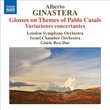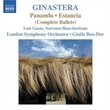| All Artists: Alberto Ginastera, Jorge Mester, Robert Whitney, Akira Endo, Louisville Orchestra Title: Ginastera: Ollantay; Pampeana No. 3; Jubilum Members Wishing: 0 Total Copies: 0 Label: First Edition Original Release Date: 1/1/2000 Re-Release Date: 11/11/2003 Album Type: Original recording remastered Genre: Classical Styles: Historical Periods, Modern, 20th, & 21st Century Number of Discs: 1 SwapaCD Credits: 1 UPC: 809157000150 |
Search - Alberto Ginastera, Jorge Mester, Robert Whitney :: Ginastera: Ollantay; Pampeana No. 3; Jubilum
 | Alberto Ginastera, Jorge Mester, Robert Whitney Ginastera: Ollantay; Pampeana No. 3; Jubilum Genre: Classical
|
Larger Image |
CD DetailsSimilar CDs |
CD ReviewsSimply too short to be attractive, unfortunately Discophage | France | 01/12/2008 (3 out of 5 stars) "When the Santa Fe Music Group acquired the rights to the Louisville catalog and started reissuing it on their First Edition Music label at the turn of the millennium, they departed from the old and not so favorable wont of the famed Louisville First Edition Records LPs, of releasing motley programs, pairing composers with hardly any stylistic or personal ties. Yet, for all the interest of these coherent, one-composer programs, Louisville didn't always have enough recordings of a given composer to sufficiently fill one CD, and consequently some of First Edition Music's offers were so short in TT as to be self-defeating propositions. This Ginastera disc is one of the most blatant cases: 41:44 is simply not enough, whatever the interest of the program. This is a case in which the label should have considered a two-composer program; Louisville had recorded other Latin-American composers, and more specifically, other Argentinians, as Robert Caamano (never heard of him otherwise, but his Magnificat came out on Louisville 563). Anyway, the disc gathers three recordings, of compositions situated at both extremes of Ginastera's compositional life. "Ollantay (A Symphonic Triptych)" from 1950 and "Pampeana No. 3 (A Pastoral Symphony)" from 1954 both date from the composer's self-styled "subjective nationalism" period, in which he wrote folk-derived and nationalistic-colored music, following the lead of Bartok (a little) and Villa Lobos (mostly). These are representative of the most popular but maybe not the most typical and original Ginastera - beginning in the late 50s he developed his so-called "neo-expressionist" style which took on all the traits of the most up-to-date contemporary music, nonetheless remaining always both dramatic and accessible, making the composer one of the best and most original Latin American composers from the '60s and '70s. Still, for all its near-clichéd nationalism, the music in these early pieces is full of subtle, impressionistic orchestral colors and of powerful statements of great dramatic impact, already pointing to the later Ginastera. In Pampeana especially, there is also a fine orchestral delicacy rising to climaxes of passionate intensity, strikingly smacking of Ravel's Daphnis. Jubilum is a late work, composed in 1983, three years before the composer's death, to celebrate the 400th anniversary of the founding of the City of Buenos Aires. Ginastera intended to write a short fanfare, but it developed in this (still too short given its value) three-movement piece, articulated in a Fanfare, a Chorale and a Finale. The middle movement has brooding brass and mysterious strings. Fanfare is filled with powerful and dissonant brass cries - elephant belches rather - joined by timpani rolls. Both it and the Finale end in powerful and sunny conclusions in major tonality. In these outer movements Ginastera's language is angular, stark, agitated but at the same time dramatic and accessible. He reminds me of Karel Husa. The awareness of the latest developments in contemporary music writing is evident, but these composers never become arcane and never relinquish their sense of color and drama. There are competing recordings of Ollontay and Pampeana 3, but this is the only one of Jubilum, which makes it all the more regrettable that the disc's unacceptably short TT rules it out, unless you can find it for really cheap. Too bad then that Louisville didn't have in their catalog another Ginastera composition, like his Concierto per Corde, one of his greatest works and one of the masterpieces of 20th Century compositions for String Orchestra. Recordings date respectively from 1969, 1954 and 1982. Ollantay came on Lou 696, coherently paired with Revueltas' Redes (not reissued). Pampeana came on Louisville 545-10 and was among the first batch of twelve subscription LPs issued by the newly founded First Edition Records. It was paired with Bergsma's A Carol on Twelfth Night, Sauguet's Les Trois Lys and Robert Ward's Euphony (only the latter has been reissued, on a Bay Cities CD from the early 1990s, BCD 1010, which I haven't found referenced on this site). Jubilum came on LS 779 with Rolf Yttrehus' weirdly wacky "Gradus ad Parnassum" (see my review of the CD reissue on CRI, The Music of Rolv Yttrehus - Symphony No. 1; Gradus ad Parnassum, for voice & orchestra; Music for winds, percussion, cello & voices; Angstwagen, for soprano voice & percussion). The transfer of Ollantay is marred by a constant background noise which sounds to me lie the surface noise from an LP, apparently belying First Edition Music's claim that it was transferred directly from the master tape. " Musical treasures to keep in mind! Hiram Gomez Pardo | Valencia, Venezuela | 08/12/2008 (5 out of 5 stars) "Jorge Mester at front of the Louisville Orchestra developed a true artistic feat, even making known pages practically unperformed of the Latin American repertoire.
His version of Ollantay for instance owns that mysterious ambiance and idiomatic distinctness that always has characterized it. It has vivid moments, bravura passages and that marvellous poetry, so rich in textures and harmonies. Tinged by Indian melodies and folk songs, this page might be regarded as the most representative and important symphonic work of this talented composer. The flawless intonation, smart intonations and phrasing clearness deserve a special place among the most and original conductors of this musical period, where the airs of musical renovation made the whole world turned its attention into Latin American musical expressions. " |

 Track Listings (9) - Disc #1
Track Listings (9) - Disc #1

